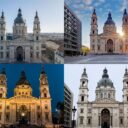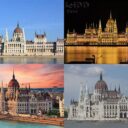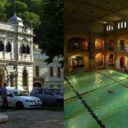For four magical nights from July 3-6, 2025, the city of Pécs (Pécs) will be illuminated by the vibrant, immersive Zsolnay Light Festival (Zsolnay Fényfesztivál). Attracting over 100,000 visitors each year, this event has grown into one of Europe’s most stunning urban spectacles, transforming the city after sunset with dazzling projections, interactive installations, and unique light art—inside galleries, across cobblestone streets, in historic squares, and even at secret venues open only for this festival.
The Expanding Universe of Light
The 2025 edition raises the bar again, integrating the Zsolnay Quarter (Zsolnay Negyed) as a new focal point. Alongside the usual city center highlights, the festival’s reach now includes a night-long journey through enchanted light gardens. Visitors can wander along mysterious paths bathed in light, where surprises await around every bend.
The Cathedral as Living Artwork: International Light Art Competition
Every evening, the imposing façade of Pécs Cathedral (Pécsi Székesegyház) becomes an epic canvas for the Zsolnay Light Art Video Mapping Competition—the festival’s flagship event. This year, artists from Hungary, the Czech Republic, Poland, and Bulgaria compete with mesmerizing animations inspired by the theme “no//body.” Expect vibrant visuals, storytelling, and fierce creativity, drawing crowds to witness architectural projection taken to new heights.
Path of Light: Highlights Across Historic Downtown
The heart of Pécs (Pécs) is reimagined along the Path of Light, guiding visitors to the city’s most breathtaking temporary transformations. The oldest residential building in town springs to life with a video mapping romance by Italian artist Francesca Maccio. At Theater Square (Színház tér), Swiss collective Encor Studio reinvents a shipping container as a flamboyant lightbox, shattering the familiar with luminescent extravagance.
Széchenyi Square (Széchenyi tér) becomes the stage for a spectacular 360-degree panorama show by Fényszórók, while this year’s dazzling light carpet is crafted by Anuri, a Budapest-based design studio. Over at Cella Septichora (Cella Septichora), Spanish maestro Javier Riera conjures hypnotic, geometric forms, inviting reflection amidst ancient ruins.
Nádor Gallery (Nádor Galéria) takes on a sci-fi twist: Koros Design’s gigantic head installation dives into the uncanny world of artificial intelligence, exploring how robots might someday master human facial expressions—an unsettling glimpse into a not-so-distant future.
Don’t skip the ARKÁD Pécs Shopping Center (ARKÁD Pécs Bevásárlóközpont), where a colossal LED screen hosts Stardust (Csillagpor) by Filip Roca and Zarko Komar. Day or night, their immersive universe asks big existential questions—Where do we come from? How do we connect? Step into the projection and become a living part of their infinite cosmic narrative.
Zsolnay Quarter: The Festival’s Dazzling New Dimension
The festival’s boldest new move brings the Zsolnay Quarter (Zsolnay Negyed) into full play, offering a standalone, evening-long adventure. The Quarter becomes a fairy-lit playground: at E78 Concert Hall (E78 Koncertterem), Balázs Varga orchestrates Center Point—an audiovisual installation where laser beams, robotic lamps, and swirling smoke interact in a precisely choreographed, sensorial dance.
Young talents from the University of Pécs (Pécsi Tudományegyetem, PTE) and Moholy-Nagy University of Art and Design (Moholy-Nagy Művészeti Egyetem, MOME) add their own light sculptures, intricate carpets, video mapping stations, domed projections, and animated statues. This transformed neighborhood quickly becomes one of the festival’s most enchanting environments.
Sanctuary of Light and Sound: Kodály Center
The Kodály Center (Kodály Központ) hosts two monumental installations. Vince Varga and his team present “The Torches Are Already Burning,” a mythic tale of boys transformed into deer, enveloped in grand, immersive digital scenery. The story unfolds amid a tulle forest on the main stage, shifting between the tangled wilds of the Mecsek (Mecsek) and familiar city streets—blurring eras in a deeply emotional, visually sumptuous retelling of Bartók’s enduring legend.
Elsewhere, Japanese artist Yasuhiro Chida’s “Analemma” creates a meditative sanctuary with webs of filament and gentle light, turning the center into the most intimate corner of the festival.
Street Theater, New Circus, and Fiery Spectacle
Day or night, the festival bustles with acrobatics and humor. Street theater and new circus acts punctuate city squares: Polip Mama is a tribute to superhero moms juggling impossible demands; Muruya crafts comic, poignant scenes about the mess and miracle of motherhood. By night, the Spanish Brincadeira troupe takes over in front of the Mosque (Gázi Kászim Pasha Mosque), blending percussion with choreographed light for feverish performances. Over in Spark Nest (Parázsfészek), the Barbakán moat (Barbakán árok) becomes a playground for fire jugglers and acrobats, ensuring the atmosphere blazes with excitement.
Visiting and Tickets
All outdoor shows on the Path of Light are free. For indoor or exclusive “Light Path Extra” events, single wristband passes are required—discounted early bird tickets are already available.
Mark your calendar for July 3-6, and get ready to be illuminated in Pécs (Pécs).





